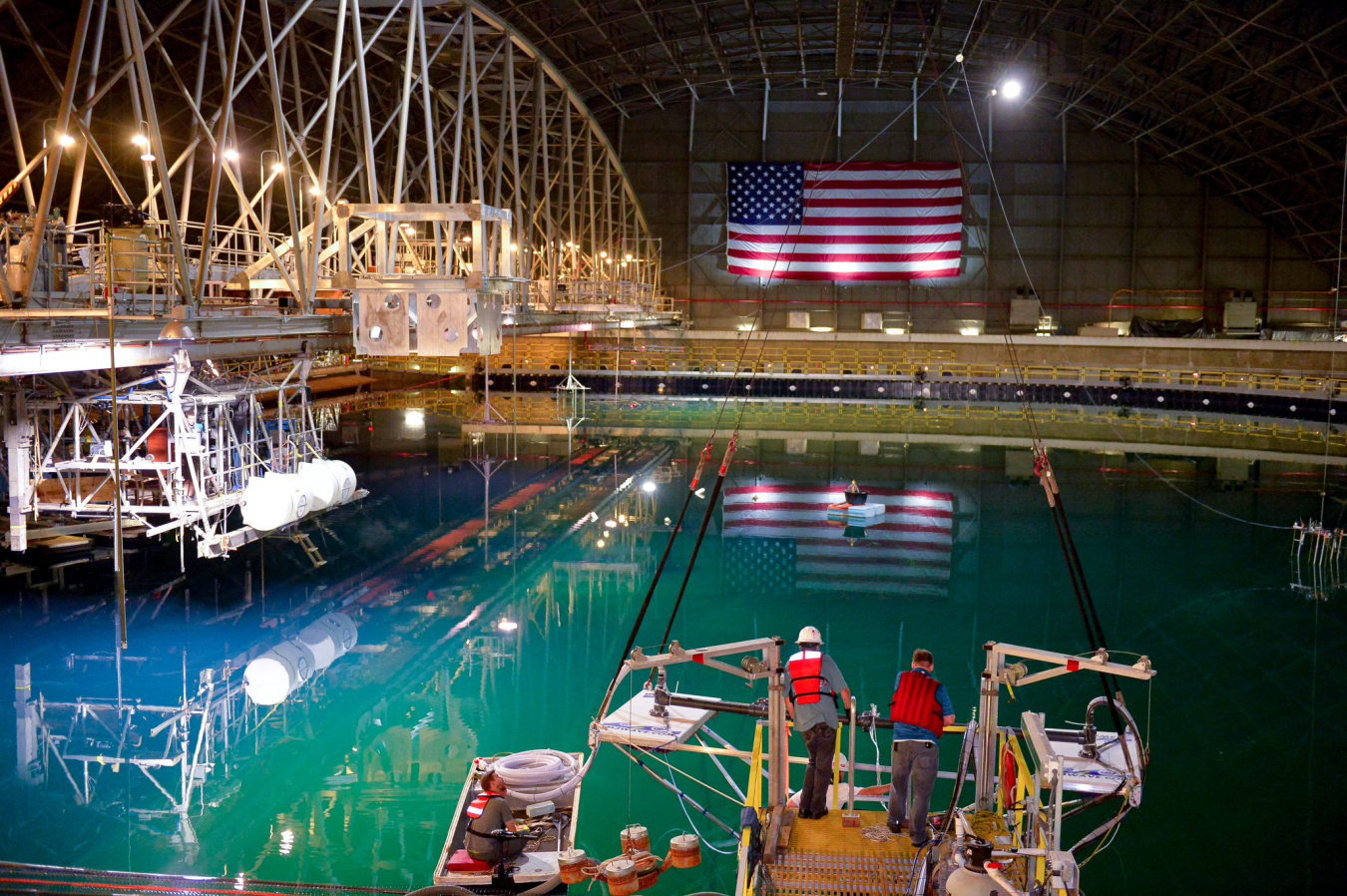
The 12-million-gallon "indoor ocean" where Wave Energy Prize testing occurs. (Credit DOE)
Blog post from WhiteHouse.gov, August 31, 2016.
Energy prizes are a potentially transformational method for the Federal government to help create clean energy technology. DOE’s Wave Energy Prize is an exciting initiative that represents an innovative approach to funding technological advancements to tap water-energy resources. The past decade has been transformative for wind and solar photovoltaic technologies, which have seen their costs fall and deployment increase dramatically. With this progress, coupled with extended tax credits for these technologies, the energy community expects years of continued growth. This does not mean that innovation in other clean technologies loses its value, however. Energy systems are most resilient when they can draw from multiple sources. In the electricity sector, for example, solar and wind produce energy only some of the time, and will need to be complemented by baseload and dispatchable low-carbon technologies such as batteries, pumped storage hydropower, geothermal energy, and other options. It is always challenging for new technologies and novel companies to enter a market, but energy has proved to be a particularly challenging sector. High capital investment requirements, long technology lifetimes, and entrenched market participants all create barriers to innovative new participants.
Incentive prizes can break through these barriers and rapidly advance the state-of-the-art by defining a problem, setting ambitious but achievable goals, and inviting diverse individuals and teams to develop solutions that are rigorously tested and only awarded if they meet high performance standards. Prizes and challenges create new avenues for organizations that would not otherwise work with the government. Innovation challenges have a track-record of engaging non-traditional audiences; for example, the recent FTC Robocall Challenge received 798 submissions and of the four winners, none had previously worked with the government. Since 2010 when the General Services Administration launched Challenge.gov, more than 700 prizes and challenges have been run by U.S. Federal Agencies. According to a 2015 report from Deloitte on prize design, between 2010 and 2014, “incentive prizes have transformed from an exotic open innovation tool to a proven innovation strategy.”
The nascent wave energy industry is an example of a “prizable” sector. First, there’s potential: more than 50% of the U.S. population living within 50 miles of coastlines, and developing just a small fraction of the available wave energy resource (the technically recoverable U.S. wave energy resource is estimated at 900-1200 terawatt hours per year) could allow for millions of American homes to be powered with this clean, reliable form of energy. Secondly, the wave energy industry is young and experiencing many new innovations and growth in patent activity across a myriad of device types, indicating potential for rapid innovation. Finally, there’s a critical need for funding in order for the private sector to develop early-concept devices and conduct prototype wave tank testing, key steps in advancing wave energy technologies through the technical readiness levels to reach commercialization.
The DOE Wave Energy Prize responds to this opportunity and aims to achieve game-changing improvements in the efficiency of wave energy converter (WEC) devices, establishing a pathway to sweeping cost reductions on a commercial scale and making them more competitive with traditional energy solutions. The 18-month design-build-test prize is now in the final stage: this month marks the start of the final prize phase in which 9 finalist teams will be competing for a grand prize of $1.5 million (with 2nd and 3rd place receiving $500k and $250k, respectively) by testing their 1/20th scale WEC devices at the nation’s most advanced wave-making facility, the U.S. Navy’s Maneuvering and Seakeeping Basin facility in Carderock, Maryland. A diverse set of 92 registered teams were incentivized to compete in this structured prize not only by the prize purse, but also through seed funding for building prototypes and covering the shipping and travel costs for teams; access to multiple testing facilities and the feedback of expert judges; and an online “marketplace” to allow for shared resources and matchmaking between teams, investors, and contributors.
The Wave Energy Prize is just one of many DOE-supported prizes designed and implemented in the energy sector to advance energy technologies, address soft costs, promote student engagement, and enhance business practices, including:
- SunShot Catalyst Energy Innovation Prize
- H2 Refuel H-Prize
- Cleantech University Prize
- L-Prize
- National Clean Energy Business Plan Competition
- EcoCAR3 Advanced Vehicle Technology Competition
- Clean Energy Ministerial’s Global Efficiency Medals
- Workplace Charging Challenge
- Solar Decathlon
- Microgrid MVP Challenge
- SunShot Prize: Race to 7-Day Solar
- Collegiate Wind Competition
- Geothermal Design Challenge 2016
- OpenWARP Challenge
- Apps for Energy
- Remote Alaskan Community Energy Efficiency Competition
- American Energy Data Challenge
- Race to Zero Student Design Competition
- Buildings Crowdsourcing Community Campaign
- Progressive Insurance Automotive X PRIZE
- BioenergizeME Infographic Challenge
In fact, DOE introduced an internal Community of Practice on Prizes, Challenges, and Innovation to share best practices and lessons learned across the Department and support nascent and current activities. Of course, DOE is not the only player in this space. Other energy sector prizes include the 1776 Challenge Cup, Clean Energy Trust Clean Energy Challenge, NRG COSIA Carbon XPRIZE, Wendy Schmidt Oil Cleanup X Challenge, and the Zayed Future Energy Prize.
Innovation will be a key ingredient for a clean energy future. Prizes in the energy space will be a valuable tool to incentivize that innovation, involve new participants in energy technology development, and gather a more diverse array of ideas than would otherwise be possible.
Noël Bakhtian is a Senior Policy Advisor at the White House Office of Science and Technology Policy.
Austin Brown is Assistant Director for Clean Energy and Transportation at the White House Office of Science and Technology Policy.
Christofer Nelson is Assistant Director for Open Innovation at the White House Office of Science and Technology Policy.
